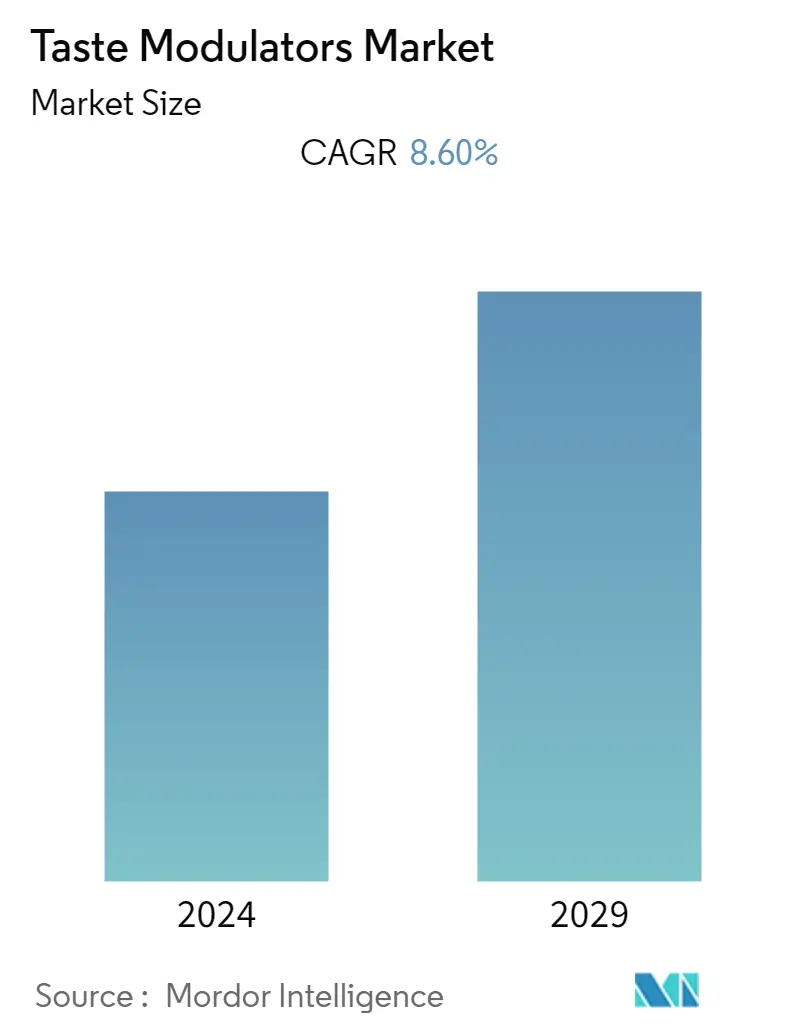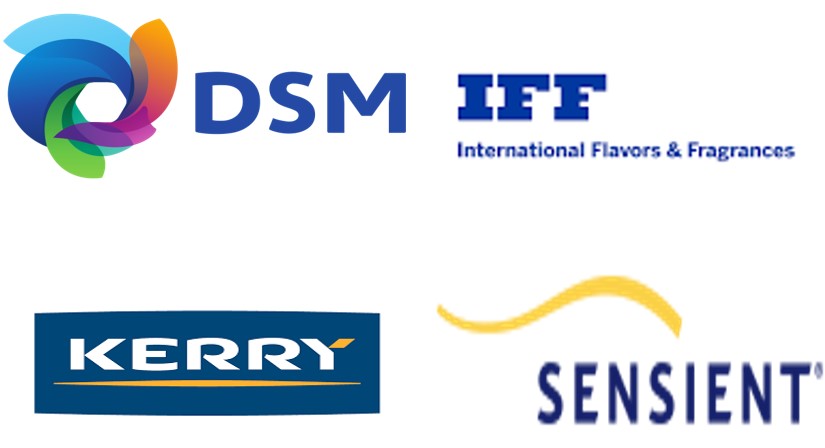Market Size of Taste Modulators Industry

| Study Period | 2019 - 2029 |
| Base Year For Estimation | 2023 |
| Forecast Data Period | 2024 - 2029 |
| CAGR | 8.60 % |
| Fastest Growing Market | Asia Pacific |
| Market Concentration | Low |
Major Players
*Disclaimer: Major Players sorted in no particular order |
Taste Modulators Market Analysis
The global taste modulators market is growing at a CAGR of 8.6% during the forecast period (2019 - 2024).
- The prevalence of obesity and diabetes across the globe with about 1.6 billion adults aged 18 and above were obese in 2016 (According to WHO), this is one of the major factors driving the demand for taste modulators in food and beverage industries. This has helped the consumers to meet their flavor requirementswithout compromising with their health.
- The implemented sugar taxes in countries, like Thailand, are driving consumers toward beverages that have less sugar. This, in turn, is driving the demand for sweet modulators in such countries. To cater to the increasing demand for flavored carbonated beverage products among consumers under different demographics, the food and beverage companies are increasingly focusing on making product lines with reduced sugar and sodium content. This is driving the growth of the taste modulator market in the end-user industries.
Taste Modulators Industry Segmentation
The global taste modulators market is studied for various food product divisions such asBakery and Confectionery Products,Dairy Products,Snacks & Savory Products,Meat Products, and others. The taste modulators used in alcoholic, as well as non-alcoholic beverages, is also studied in detailed. The different types of taste modulators used in the food and beverage industries include sweet modulators, salt modulators and fat modulators. The market is studied in detailed for both mature as well as developing countries across the globe to provide a broader perspective.
| Application | |||||||
| |||||||
|
| Type | |
| Sweet Modulators | |
| Salt Modulators | |
| Fat Modulators |
| Geography | |||||||||
| |||||||||
| |||||||||
| |||||||||
| |||||||||
|
Taste Modulators Market Size Summary
The taste modulators market is experiencing significant growth, driven by the increasing global prevalence of obesity and diabetes, which has heightened consumer demand for healthier food and beverage options without sacrificing flavor. The implementation of sugar taxes in various countries, such as Thailand, is steering consumers towards low-sugar beverages, thereby boosting the demand for sweet modulators. Food and beverage companies are responding by developing product lines with reduced sugar and sodium content to cater to the growing consumer preference for flavored carbonated drinks across different demographics. This trend is further supported by the rising consumer inclination towards health-oriented products, making taste modulators an essential component in the functional food and beverage industry. The convenience of products labeled as "ready to drink" and "on the go," along with health claims like reduced calorie and reduced sodium, is further propelling the demand for taste modulators, particularly sweet and salt modulators.
In Asia, increased health consciousness among consumers in countries such as China, Japan, Australia, and India is driving the demand for food and beverages with health claims. Governments in several countries, including Thailand, Singapore, and Australia, have imposed sugar taxes to combat obesity and diabetes, prompting the food and beverage industry to seek sugar alternatives. The rising popularity of sports drinks among fitness-focused consumers, due to the growing importance of pre-workout and post-workout supplements, is also expected to contribute to market growth. Key players in the global taste modulators market, such as Koninklijke DSM N.V., International Flavors & Fragrances Inc., and Kerry Inc., are actively engaging in product innovation and expansion strategies, including mergers and acquisitions, to strengthen their market presence and optimize their offerings. These companies are also collaborating with local players to enhance their dominance in regional markets.
Taste Modulators Market Size - Table of Contents
-
1. MARKET DYNAMICS
-
1.1 Market Drivers
-
1.2 Market Restraints
-
1.3 Porter's Five Forces Analysis
-
1.3.1 Bargaining Power of Suppliers
-
1.3.2 Bargaining Power of Buyers/Consumers
-
1.3.3 Threat of New Entrants
-
1.3.4 Threat of Substitute Products
-
1.3.5 Intensity of Competitive Rivalry
-
-
-
2. MARKET SEGMENTATION
-
2.1 Application
-
2.1.1 Food
-
2.1.1.1 Bakery and Confectionery Products
-
2.1.1.2 Dairy Products
-
2.1.1.3 Snacks & Savory Products
-
2.1.1.4 Meat Products
-
2.1.1.5 Others
-
-
2.1.2 Beverage
-
2.1.2.1 Alcoholic Beverages
-
2.1.2.2 Non-Alcoholic Beverages
-
-
-
2.2 Type
-
2.2.1 Sweet Modulators
-
2.2.2 Salt Modulators
-
2.2.3 Fat Modulators
-
-
2.3 Geography
-
2.3.1 North America
-
2.3.1.1 United States
-
2.3.1.2 Canada
-
2.3.1.3 Mexico
-
2.3.1.4 Rest of North America
-
-
2.3.2 Europe
-
2.3.2.1 Spain
-
2.3.2.2 United Kingdom
-
2.3.2.3 Germany
-
2.3.2.4 France
-
2.3.2.5 Italy
-
2.3.2.6 Russia
-
2.3.2.7 Rest of Europe
-
-
2.3.3 Asia Pacific
-
2.3.3.1 China
-
2.3.3.2 Japan
-
2.3.3.3 India
-
2.3.3.4 Australia
-
2.3.3.5 Rest of Asia-Pacific
-
-
2.3.4 South America
-
2.3.4.1 Brazil
-
2.3.4.2 Argentina
-
2.3.4.3 Rest of South America
-
-
2.3.5 Middle East and Africa
-
2.3.5.1 South Africa
-
2.3.5.2 United Arab Emirates
-
2.3.5.3 Rest of Middle East and Africa
-
-
-
Taste Modulators Market Size FAQs
What is the current Taste Modulators Market size?
The Taste Modulators Market is projected to register a CAGR of 8.60% during the forecast period (2024-2029)
Who are the key players in Taste Modulators Market?
Koninklijke DSM N.V., International Flavors & Fragrances Inc., Sensient Technologies Corporation, The Flavor Factory and Kerry Inc. are the major companies operating in the Taste Modulators Market.

